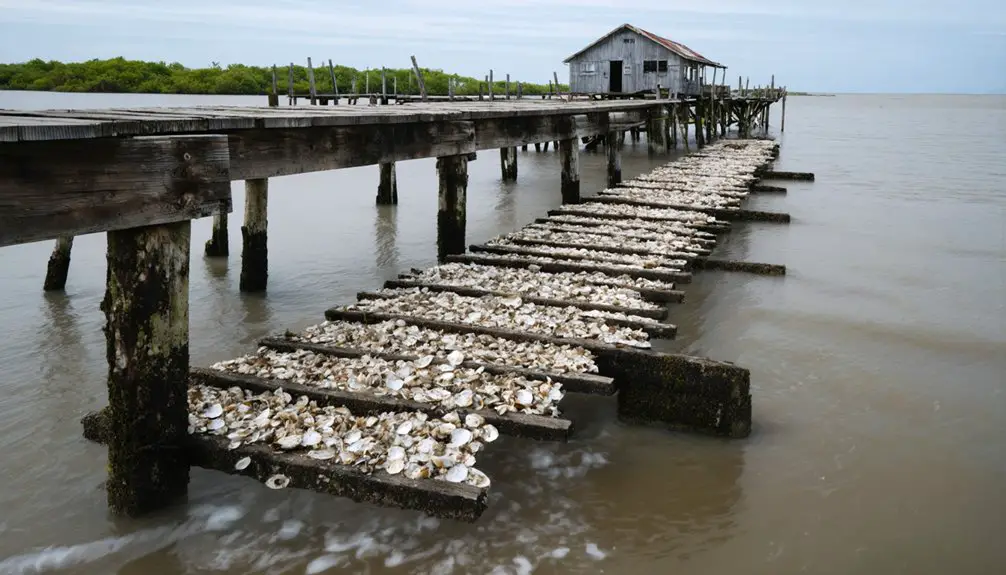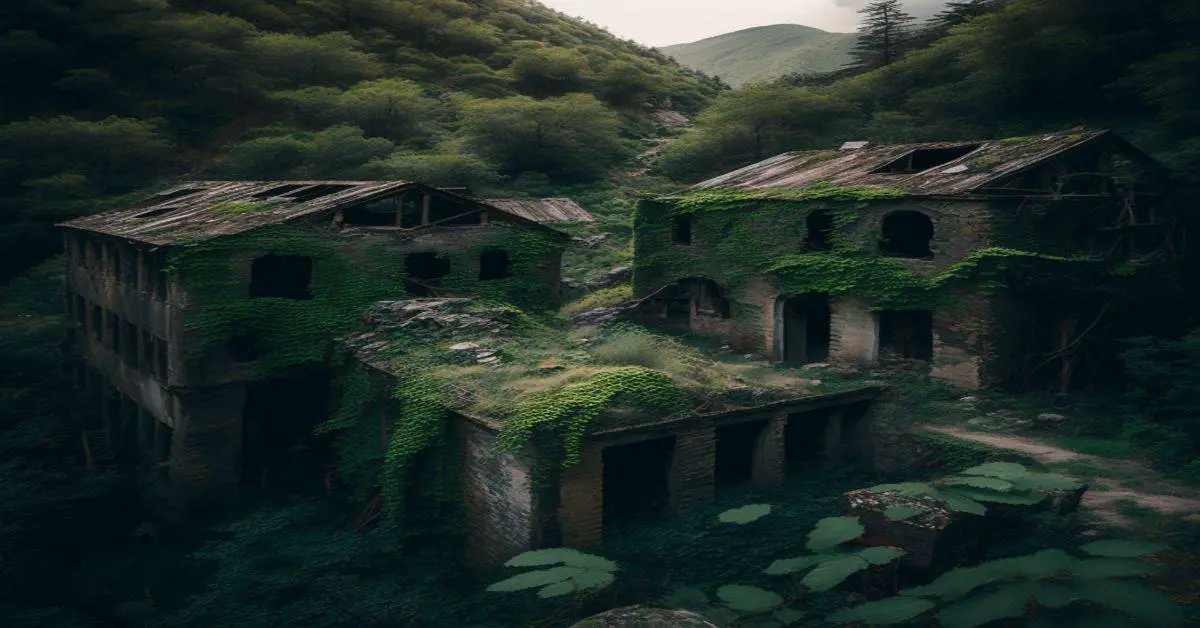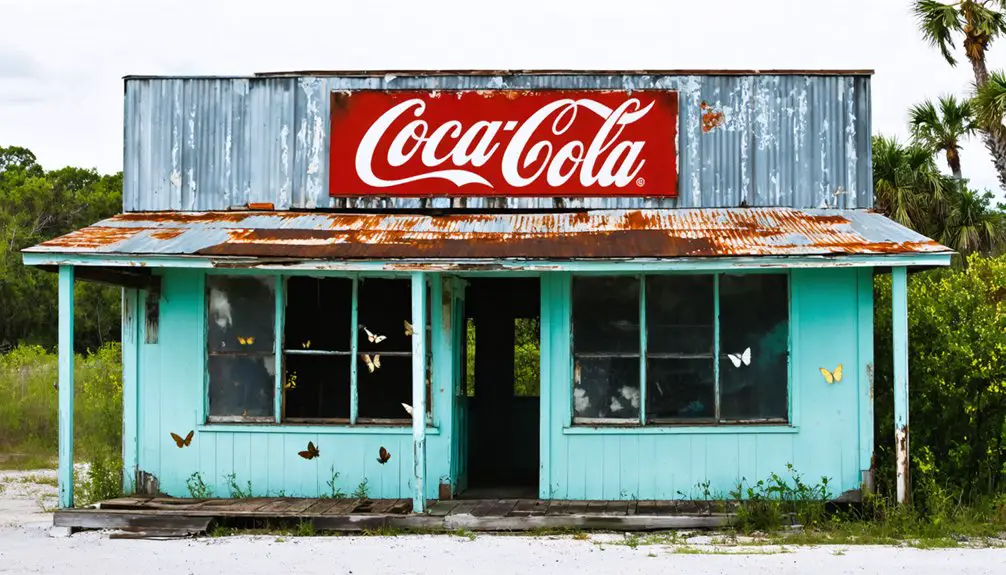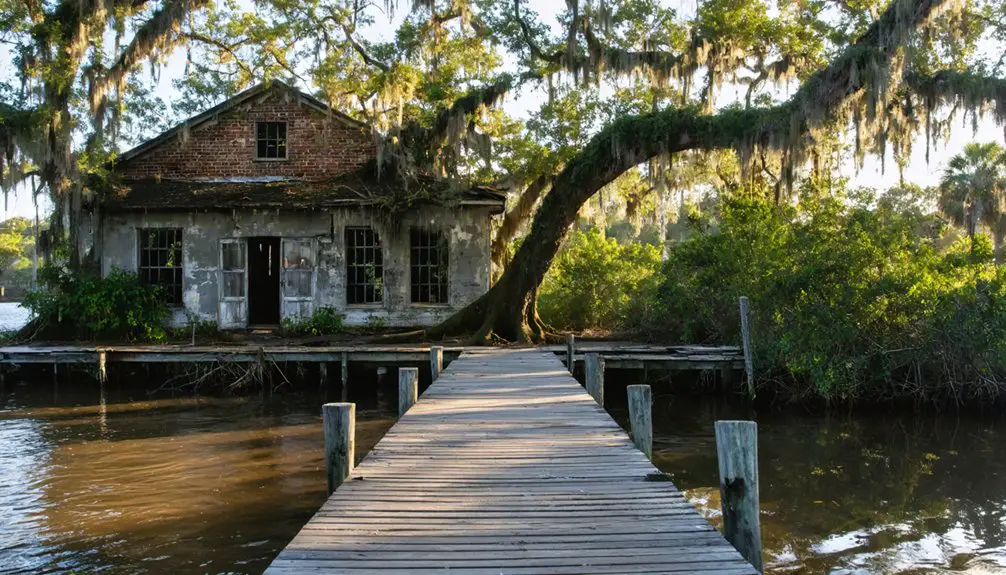You’ll find Cedar Key’s ghostly legacy in its transformation from a thriving 19th-century port town to a haunting coastal settlement. After the devastating 1896 hurricane destroyed the Eberhard Faber cedar mills, this once-bustling maritime hub fell into decline. Today, you can explore the remnants of Atsena Otie Key’s cemetery, the historic Island Hotel’s spectral residents, and pirate legends at Seahorse Key. Cedar Key’s dark past holds even more mysterious tales waiting to be uncovered.
Key Takeaways
- Atsena Otie Key, Cedar Key’s original settlement, became a ghost town after the devastating 1896 hurricane destroyed the community.
- The abandoned Eberhard Faber cedar mill ruins stand as remnants of Cedar Key’s once-thriving lumber industry.
- Cedar Key’s population drastically declined following the 1896 hurricane and collapse of the shipping industry.
- Historic cemeteries and building ruins on Atsena Otie Key serve as a memorial to the former bustling settlement.
- The Eagle Pencils factory closure and cedar depletion contributed to Cedar Key’s transformation from industrial hub to quiet fishing village.
The Haunted Legacy of Atsena Otie Key
While Atsena Otie Key stands as a silent sentinel off Florida’s Gulf Coast today, its haunting legacy began as a thriving 19th-century settlement.
You’ll discover an island shaped by tragedy, from the destructive Civil War battles that ravaged its shores to the devastating 1896 hurricane that sealed its fate.
The haunted history echoes through the restored cemetery and crumbling ruins, where Union raids once captured civilians and destroyed essential industries.
As you explore the overgrown paths where the bustling Eberhard Faber cedar mill once stood, you’ll sense the ghostly encounters of a community that vanished into time. Today, visitors can learn more about this ghost town’s past through the Indian artifacts displayed at the Cedar Key Museum.
The island’s violent past and sudden abandonment have created an atmospheric reflection of Florida’s coastal heritage, drawing visitors who seek to connect with its mysterious past. A scenic walking trail leads visitors from the dock through the historic grounds to the restored cemetery.
Pirates, Ghosts, and Hidden Treasures
Beyond the haunted ruins of Atsena Otie Key lies an even darker chapter in Cedar Key’s history – its era of piracy and buried treasure.
In the 18th and early 19th centuries, notorious pirates like Jean Lafitte and Captain Kidd used these waters as their personal playground, with Seahorse Key serving as their lookout point. They’d slip through the back marsh waterways, leaving whispers of buried riches in their wake. The mysterious death of Pierre, Lafitte’s trusted guardian, adds credence to tales of hidden wealth on these shores. Each December, the community hosts a three-day Pirate Invasion that transforms the historic downtown into a bustling pirate camp.
Today, you’ll find pirate lore deeply woven into Cedar Key’s identity. The annual Pirate Invasion festival brings these tales to life, while treasure hunting enthusiasts still scour the islands’ remote corners.
Cedar Key keeps its pirate heritage alive through festivals and treasure seekers exploring its mysterious shores.
Local legends tell of spectral figures guarding long-lost treasures, especially around Seahorse Key at night. While no confirmed pirate cache has been found, the complex geography of marshes and waterways keeps the mystery alive.
The Island Hotel’s Mysterious Residents
Since its construction in 1859, the Island Hotel has cultivated a reputation for both hospitality and hauntings.
During its colorful history as a general store, Civil War quarters, speakeasy, and brothel, the building has collected its share of ghostly encounters. You’ll hear tales of a Confederate soldier who appears at an upstairs window, and whispers of a former owner’s mysterious poisoning death. The walls of this historic structure, made from oyster shell and limestone, have witnessed generations of visitors.
The hotel’s physical characteristics heighten its eerie atmosphere – sloping floors that creak and groan, thick tabby walls that shift with the seasons, and the absence of modern distractions like TVs. Today, the bed and breakfast continues operating with 10 intimate rooms that preserve its historic charm.
While the Neptune Lounge downstairs buzzes with live music and socializing, upstairs you might experience spectral sightings that remind you of the building’s dramatic past spanning over 140 years.
Dark History and Local Legends
Though Cedar Key projects a quaint coastal charm today, the town harbors a dark history of racial violence that peaked in 1923 when local residents participated in burning the nearby Black community of Rosewood.
This tragic event marked the beginning of a dark period, as Cedar Key’s own African American population sharply declined between 1930-1940. Reports suggest up to 27 Black individuals were killed during this era, while others fled the region entirely.
The town’s troubled past lives on through local legends, particularly at the Island Hotel, where spirits of murdered individuals allegedly roam the halls. A faded sundown sign near the dock in 1967 served as a lingering reminder of the town’s discriminatory practices.
A “sundown town” mentality persisted into the 1960s, erasing much of Cedar Key’s rich African American heritage, though traces remain in the integrated cemetery where Black and white residents share eternal rest. Recent research has revealed ninety unmarked graves through ground-penetrating radar surveys of the historic cemetery.
A Time Capsule of Old Florida
When Florida was still a raw frontier in the 1840s, Cedar Key emerged as one of the state’s earliest settlements, transforming from a military outpost into a bustling maritime hub.
You’ll find remnants of this historic preservation in the town’s tabby construction, wood-frame buildings, and the towering Seahorse Key lighthouse that once guided merchant vessels 16 miles out to sea.
The cultural heritage of Cedar Key’s golden age lives on through its railroad legacy and maritime roots. The Eagle Pencils factory established operations here, leading to extensive cedar harvesting throughout the region.
Cedar Key’s soul echoes through the whispers of locomotive steam and salty harbor winds, a living testament to Florida’s seafaring past.
In the 1880s, you could’ve witnessed 17 bustling sawmills producing half a million board feet of lumber weekly, while steamboats and trains connected this essential port to both the Atlantic and Gulf coasts.
Though Tampa’s railroad eventually eclipsed Cedar Key’s prominence, the town’s preserved infrastructure tells the story of Old Florida’s ambitious spirit. The devastating 1896 hurricane destroyed many mills and severely impacted the shipping industry.
Frequently Asked Questions
How Deep Is the Water Between Way Key and Atsena Otie?
You’ll find water depths between Way Key and Atsena Otie ranging from 1.5 feet at low tide to 4.5 feet during high tide, making channel navigation tricky without careful timing.
Are There Any Remaining Indigenous Artifacts Visible on the Islands Today?
Like whispers from the past, you’ll find indigenous history through pottery shards and shell tools at Cedar Key Museum, while the massive Shell Mound site reveals 6,000 years of cultural significance through visible artifacts.
When Is the Best Season to Spot Dolphins Around Cedar Key?
You’ll find the best dolphin viewing in late March through April, when multiple species are active simultaneously. Winter’s also excellent, especially January, despite cooler temperatures. Summer brings large social groups too.
What Happened to the Original Lighthouse on Seahorse Key?
You’ll find the original lighthouse still standing on Seahorse Key – it wasn’t destroyed. Built in 1854, it’s operated intermittently, was dark for a century, and got relit in 2019 with a replica lens.
Do Any Descendants of Early Cedar Key Settlers Still Live There?
Like roots of ancient oaks, you’ll find descendants of early settlers still maintaining Cedar Key heritage today, with many families tracing their connections back to Georgia and South Carolina migrants.
References
- https://www.latimes.com/archives/la-xpm-1990-06-10-tr-60-story.html
- https://cedarkeynews.com/Archives/OLDSITE/Features/278-315.html
- https://www.dwhiteandco.com/home/2024/12/13/cedar-key-is-changing-but-ghosts-still-linger
- https://www.youtube.com/watch?v=-0WjnHyKHT0
- https://en.wikipedia.org/wiki/Atsena_Otie_Key
- http://seecedarkey.com/history-of-cedar-key/
- https://www.floridasnaturecoastconservancy.org/property-acquisition/atsena-otie/
- https://www.youtube.com/watch?v=VBpRSnyXTr8
- https://lsa.anthro.ufl.edu/projects/storms-of-the-past-stories-for-the-future/
- https://cedarkeypiratefest.com/home-old/



